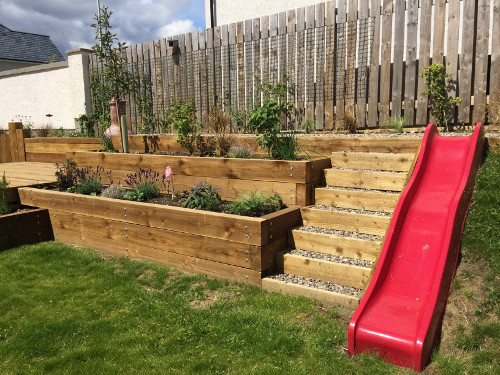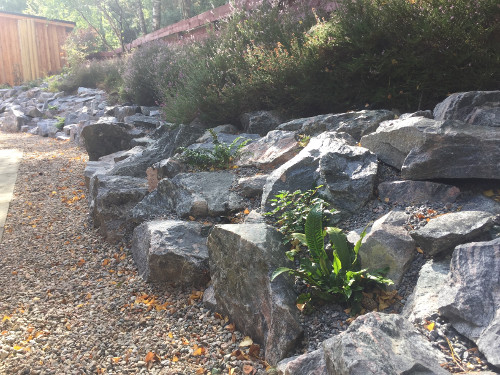
What to do with a sloping garden...
After years of designing, constructing and excavating sloping gardens, we can conclude that slopes present their own special challenges. But don’t fret if your garden has a slope; with smart design and good construction these challenges can be overcome. Here, we talk about how to embrace a sloping garden and make the most from it.
The benefits of a sloping garden
A natural contour in a garden provides visual interest. This can be exploited by working with the ground’s slope to create distinct areas within the garden. It can, for example, allow for a raised decking area for relaxing and dining, overlooking a lower lawn area where kids can enjoy playing games.
Also, a slope can offer natural vantage points within garden, of both the garden and beyond, and these spots can make perfect sitting areas.
Where a garden is sloping up from the house, you can show off attractive features within the garden which can be viewed from inside the house. Conversely, where a garden is sloping away from the house, less attractive features, can be hidden out of sight.
Water features are particularly effective in sloping gardens, where the natural gradient provides the chance to create meandering streams, pools and waterfalls. Not only do water features add beauty, they can also help with drainage, an important consideration in designing a sloping garden.



Designing a sloping garden
Start by thinking about what you want from your garden. For instance; a decking or patio area for relaxing and entertaining? A lawn where your kids can enjoy playing games? Or maybe an area to grow vegetables or cut flowers?
Once you know the features you’d like, it is then a case of figuring out how best to use the space to accommodate them. And with sloping gardens smart use of space is key.
It is also important to think about how your garden will be viewed. As mentioned above, depending on the slope, you’ll have the chance to either show off or hide away features, so consider carefully what you want to see, and what you don’t want to see, when looking out on your garden.

Important considerations when building a sloping garden
Constructing a sloping garden can be tricky, especially where there is a significant slope. When building levels and terraces within the garden it is important that all retaining walls are soundly constructed. Good drainage is vital, and it is important that weep holes are included in all retaining walls.
Drops between different levels will be inevitable but aim to minimize them to ensure that your garden is safe. Also, steep steps and paths are potentially hazardous, so think about how best to make your garden accessible and easy for all to move around. One simple solution is to curve steps and paths across a slope to lessen their severity.
Making sure that your garden is easy to get around will also make maintenance easier. Consider adding ramps between levels, which will be helpful when using a lawn mower and other gardening equipment.

Soil Erosion & choosing the right plants
Soil erosion is an issue with severe slopes, but this can be tackled by picking suitable plants. Drought-tolerant plants with deep roots are most effective for stabilising steep slopes, so consider ornamental grasses and wildflowers, ground-covering geraniums and a large variety of shrubs and trees.
For good ground cover on slopes, creeping conifers, cotoneaster, lonicera and heathers work well. Ivy and vinca are also commonly used but be aware that they can become invasive.
To help retain moisture, build small horizontal levels into the slope to make watering more effective. In time these small levels will become less visible.
Don’t be scared, sloping gardens can be great!
Yes, a sloping garden presents its own unique challenges, but hopefully you can see that with clever design and good construction these challenges can be overcome. In fact, sloping gardens offer up opportunities that you don’t get when working with flat gardens. So, embrace your sloping garden and create something wonderful!





